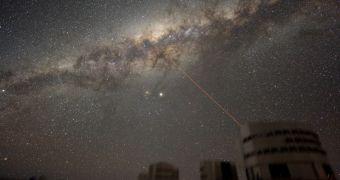While stars located in the arms or halo of spiral galaxies such as the Milky Way have a relatively straightforward orbit around the galactic core, celestial fireballs located inside the central bulge are likely to take on eccentric orbits that are very difficult to analyze. A new study develops an advanced model of how stars at the core of the Milky Way move.
The galactic core is an environment that is extremely different from the halo. Billions of stars crisscross their orbits around Sagittarius A*, the supermassive black hole powering up the Milky Way. Huge clouds of dark matter swirl at this location as well, further disrupting stellar orbits around the core.
Some studies have suggested that these factors, plus several others, make stars in the center of the galaxy move in banana-like orbits. However, the new paper suggests that the objects are far more likely to travel in peanut shell- or figure-eight-like orbits.
Details of the new investigation appear in a paper published in this week's issue of the esteemed journal Monthly Notices of the Royal Astronomical Society, Science Blog reports. Understanding the orbits of central stars is important because it can shed new light on how the galactic bulge grows over time.
The central regions of the Milky Way are made up of a bar – a structure containing vast amounts of stars orbiting the black hole – and a bulge. The latter is made up of stars that move out of the galactic plane, and recent measurements suggest that it keeps growing.
This process is caused by stars located outside the plane that continuously modify their orbits with each pass around the galactic core. Over hundreds of millions of years, their constantly changing paths make the bulge appear to grow vertically, as seen from far away outside the Milky Way.
The new research, led by University of Rochester professor of astronomy Alice Quillen, resulted in the development of a computer model that predicts how stars at the galactic core will travel around the black hole over time, and how their orbits will change under the influence of diverse factors.
“It is hard to look back into the past of our galaxy and know what was there, but simulations can give us clues. Using my model I saw that, over time, the resonance with the bar, which is what leads to these peculiarly shaped orbits, moves outwards. This may be what happened in our galaxy,” Quillen says.
Analyzing the galactic core will become a lot easier once the European Space Agency (ESA) launches its Gaia mission. The telescope will spend 5 years in space conducting 70 full sweeps of the night sky. Its mission is to chart the motions of at least 1 billion stars in the Milky Way, and create a 3D map of the galaxy.

 14 DAY TRIAL //
14 DAY TRIAL //